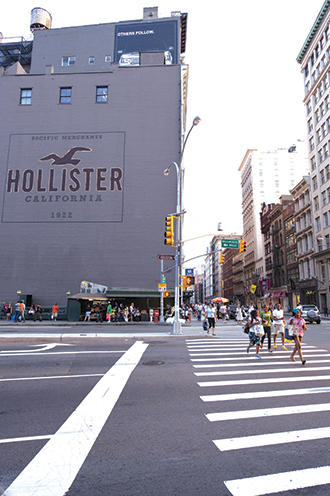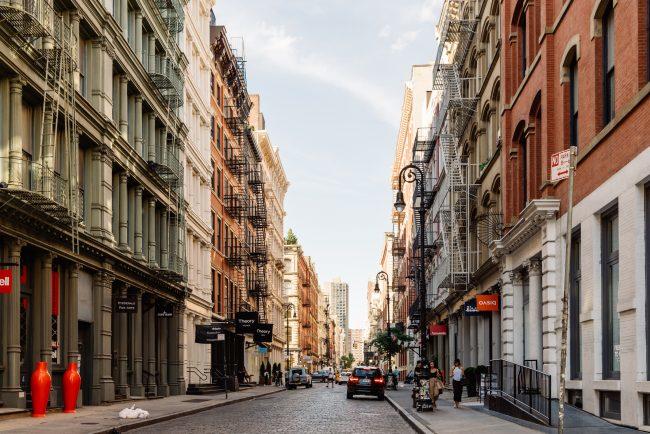Trending
Restoring Soho’s sacred ground?
The neighborhood’s complicated zoning — designed for artists and manufacturers — is creating headaches for property investors and lenders as the city seeks to implement changes

Hollister’s massive flagship in Soho is one of the first stores subway riders see when they emerge from the Broadway-Lafayette station. The six-story building at the corner of Broadway and East Houston Street — two of the neighborhood’s busiest thoroughfares — is a coveted location.
But the apparel maker’s nine-year residency at 600 Broadway isn’t just bold for its placement and scale. It could be illegal. Despite being a prime retail destination, Soho is not zoned for widespread ground-floor retail use. And for the most part, the only residents permitted to live in the neighborhood are those officially certified as artists by the city.
In recent months, New York officials have moved to align Soho’s zoning rules with the neighborhood’s reality. Manhattan Borough President Gale Brewer and City Council member Margaret Chin are leading the charge to potentially lift what some industry observers call outdated zoning laws in Soho and nearby Noho.
“If you think about Soho, it’s pretty much all retail, office and residential,” said Brian Steinwurtzel, a principal and co-CEO of GFP Real Estate, which owns property in the area. “The actual makeup of the area doesn’t reflect the zoning.”
Though the planning is still in the preliminary phase, the goal is to permit more as-of-right uses. That has unnerved some longtime neighborhood advocates who believe the proposed zoning changes could push out current residents or send the wrong message about how the city’s zoning laws should be enforced. “If it ain’t broke, don’t fix it,” said Sean Sweeney, director of the Soho Alliance, a local community group. “It’s going to open up a Pandora’s box of hurt.”
As it stands, the neighborhood’s zoning poses a big problem for landlords and tenants, as well as for investors and lenders seeking certainty when sinking money into Soho properties. Some say that in order to lessen the risks associated with buying into a building zoned solely for artists or lending on such a property, the city needs to provide more clarity about Soho’s zoning rules.
“That disconnect and dissonance between what is supposed to be here and what’s actually here hurts everyone,” said Margaret Baisley, a real estate lawyer who has advised artists living in Soho. “We can’t, in my opinion, have a system that allows massive violation of the law.”
Investors turned enforcers
The ground floor of 600 Broadway, like most of Soho, is zoned solely for manufacturing use. Hollister, however, occupies 37,500 square feet of space in the roughly 65,000-square-foot building — from the cellar to the second floor. 
In July, the New York City Department of Buildings slapped the building’s landlord, Aurora Capital Associates, with two illegal use violations. Three other major retailers on Broadway — Topshop, Uniqlo and Zara — were, along with their landlords, hit with violations for occupying larger space than allowed under Soho’s current zoning. The violations — many in the form of fines for the fairly inconsequential sum of $800 — are pending and await hearings before the city’s Office of Administrative Trials and Hearings.
“A witch hunt was drummed up by a few very negative and vocal members of the residential community with the support of local politicians,” Jared Epstein, a vice president and principal at Aurora, told The Real Deal by email. “It’s a shame that the majority of the residents and property owners in the neighborhood don’t make their opinions known. If they did, Soho would be a much more positive place to live, work and shop.”

Retail stores on Greene Street in Soho
Enforcement of zoning regulations largely falls to lenders and investors who need to consider the risk of bankrolling a property that doesn’t permit retail use or is reserved for certified artists. Amanda Hudson, a broker with Dallien Realty, said she recently had a client from South Korea who was interested in buying a Soho rental property but backed out due to zoning restrictions that made the deal financially unfeasible. And Baisley noted that three sales she was recently involved with were scuttled due to Soho’s artist-in-residence (AIR) requirement.
Buying such a Soho property, even if its previous owners defied the city’s zoning restrictions, could result in a monetary loss if the DOB and other city officials move forward with stricter zoning enforcement. Providing a mortgage on an AIR property is similarly risky for those trying to pencil out the particulars on a Soho real estate deal.
“The zoning, as it exists, is a buggy whip. It’s outmoded, it should be thrown away,” said Andrew Singer, CEO of the Singer & Bassuk Organization, a boutique commercial mortgage brokerage. “Most lenders treat the regulations seriously, and it impacts their willingness to lend.”
Aurora’s Epstein noted that following the 2008 financial crisis, banks instituted stricter lending requirements on AIR apartments out of fear of foreclosing on a property with such restrictions.
“A bank doesn’t want to be in the position of having to foreclose and then only being able to sell to an artist,” said Mitchell Korbey, a partner and chair of the land use and zoning group at law firm Herrick, Feinstein. “The bank doesn’t want to be holding something that is of much lower value than the mortgage.”’
Lax rules and ongoing uncertainty
Though it’s rare, some developers have gone through a months-long process of securing a special permit to skirt the AIR restriction. For example, Veracity Development received approval in 2012 for its renovation of 111 Mercer Street, a four-unit luxury condo building.
Real estate attorney and developer Edward Mermelstein said Soho’s unique zoning deters other developers from embarking on new neighborhood projects. He noted that few developers get excited about creating a building for artist tenants. 
A recent study by the Soho Broadway Initiative, the neighborhood’s business improvement district, found that Soho has approximately 25,000 residents, 3 million square feet of retail space and 9.6 million square feet of residential space. In 2016 and 2017, the city received 22 applications for artist certification in the neighborhood and approved 15, according to data provided by the Department of Cultural Affairs. In 2018, the city received only three applications and rejected all but one. Cultural Affairs representatives said there is no way to tell how many certified artists still live in Soho.
Although such property owners as Veracity have received special permits or variances to get around current zoning, others are just ignoring the rules. Baisley, who has advised on Soho-related transactions for more than 35 years, said disregard for local residential and retail restrictions is “widespread.”
“It’s really noncompliance with the zoning requirements here that’s creating uncertainty in the market,” she said.
In some sales, co-op and condo boards will accept a waiver that specifically shifts the risk of violating a building’s certificate of occupancy to the buyer. In these cases, the resident signs a letter absolving the board of any responsibility in the event the DOB comes knocking. Such arrangements, however, are particularly perilous in buildings with temporary certificates of occupancy, which must be renewed every 90 days. The city could decide to deny issuing a TCO until a building complies with its permitted use.
The DOB seems to have shied away from penalizing those who ignore residential regulations. Baisley said many people feel that spending money on “art police” is a waste of time and resources. DOB representatives could not provide any recent enforcement actions related to AIR but noted that residents are encouraged to call 311 to report potential violations.
“Why isn’t there a crackdown on those groups?” asked Steinwurtzel of GFP Real Estate. “The reason is simple: The city doesn’t want to kick people out of their homes.”
Though New York has not taken substantive action against illegal residences, artists in Soho have taken aim at their neighbors. In one lawsuit filed in 2011, which remains pending, certified artist Maxi Cohen has been fighting to force board member Thomas O’Neill out of his fourth-floor co-op at 31 Greene Street. O’Neill is not a certified artist, and no member of his family is a certified artist, according to court documents filed in the case by Cohen, who owns a fifth-floor unit and another second-floor apartment with her brothers in the five-unit, five-story building.
“[T]he building shall be occupied by artists and their families as combined living-working quarters and for business purposes in connection with the creation, display and sale of their artwork,” Cohen said in her civil complaint.
Artful zoning
Soho has a long history of residents and businesses inhabiting space illegally.
Current zoning regulations in the area date back to the 1890s, when high-ceilinged loft buildings provided the perfect space for manufacturers who used the upper floors to create and the ground floors to sell their products. When those manufacturers began leaving in droves by the 1950s, artists began taking over the rundown buildings that such businesses left behind.
Roughly 660 artists lived in Soho by 1968, defying the neighborhood’s zoning as a manufacturing district, according to a New York Times story that year. To accommodate the growing community, the city tweaked Soho’s zoning in 1971 to allow artists to legally live and work in the area. The change also grandfathered certain existing ground-floor retail in Soho. In 1982, New York State passed the Loft Law, which eventually created a path for residents — including non-artists — to live legally in buildings zoned for manufacturing use.
Under the latest version of the law, which is periodically updated, residential use is permitted in buildings where three or more families lived independently during any consecutive 12-month period, the most recent of which is between 2008 and 2009. The city offers a few other avenues to get around Soho’s current zoning, such as a variance or special permit through the city’s Planning Commission or Board of Standards and Appeals.
Soho residents still need to be certified by Cultural Affairs, despite the perceived decline of the neighborhood’s artist population. Potential residents must submit portfolios demonstrating a body of professional work in the fine arts. “Professional” in this context refers to the “artist’s commitment to his or her vocation,” since the city recognizes “that the majority of artists do not earn their living through sales of their artwork,” according to the application for certification.
“The only people who are living in Soho are high-net-worth individuals,” said Hudson of Dallien Realty. “These artists aren’t the artists who lived here in the 1970s.”
The money flowing into Soho in recent years shows that it remains a desirable destination for investors. The neighborhood saw almost $1.3 billion worth of residential sales between Jan. 1, 2014, and Dec. 10, 2018, a TRD analysis of public records revealed. During that same period, Soho had $950 million worth of retail property sales, with $940.1 million of that total coming within the last three years alone.
Asking rent for Soho retail space, meanwhile, fell to $417 per square foot in 2018’s third quarter, marking an 11.7 percent year-over-year decrease, per Cushman & Wakefield. The commercial brokerage noted that Soho’s availability rate had soared to 23.9 percent during that time.
“Soho became the poster child for vacancy and the retail apocalypse,” Aurora’s Epstein noted. “Retail vacancy is a detriment to a community, and therefore residential apartment values in Soho are on the decline and will continue to [drop] unless the retail problem is fixed.”
Sweeney, the Soho Alliance director whose organization helped champion the area’s 1971 zoning change, said something must be done in order to prevent legally dubious leases from becoming the new neighborhood norm. But he argued that the city shouldn’t change the rules to accommodate those who are violating current zoning regulations.
“Are we a nation of laws?” Sweeney asked. “Or are we still the Wild West in Soho?”




